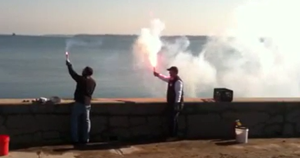Posted: September 9, 2015
Aboout This List
This Safety Checklist is intended for Bluewater Cruisers and was adapted from the 2015 Transpacific Yacht Race Certificate of Inspection. You can read the original
here. The Transpac checklist is adapted from the comprehensive and interesting ISAF regulations for offshore races which is 60 pages long and is available
here.
Racing regulations are useful as they have evolved over years of experience as racers have encountered and documented numerous emergencies and developed equipment and procedures for addressing them. On the other hand, offshore racers press their boats harder and often sail through worse conditions than most cruisers.
Different people have different levels of experience and are comfortable accepting different levels of risk. Offshore sailing is inherently dangerous. Skippers may choose to add or omit items. If you are a skipper, you have an obligation to inform your crew of items you have chosen to omit and educate them on items you have added. Similarly, if you are crew, you have a right to know what safety equipment in on board and what is omitted so you can choose whether a specific voyage is within your comfort zone.
Contact Information:
Share this contact information with others before you depart.*
| Date of Check: | |
| Yacht Name: | |
| Skipper Name: | |
| Offshore Email Address: | |
| SAT phone number: | |
| Yellow Brick ID: | |
| EPIRB ID: | |
| Yacht Call Sign: | |
| Yacht MMSI Number: | |
Below Deck:
A durable waterproof Safety Equipment Location Chart should be displayed where it can best be seen, marked with the location of all safety equipment.
A durable waterproof Thru-Hull Chart showing the location of all through-hulls should be display where it can best be seen.
A durable waterproof Emergency Radio Procedures Chart showing yacht particulars and calling procedures on radios, SAT Phone, Yellow Brick, etc. where it can best be read while using the radios.*
Navigation equipment AND charts for this voyage (not solely electronic) Light list and chart plotting equipment.
Emergency water – 1 Gallon per crew member in stout 1 gal. containers or in stout 5 gal. Jerry Jugs.
Fire extinguishers, at least two and no fewer than required by the yacht’s country of registry, readily accessible in suitable and different parts of the yacht.
Two (2) Manual bilge pumps (one in cockpit near helm, second one below deck) with lanyards attached to handles & two (2) buckets w/lanyards. Test all bilge pumps for proper operation.
Communication equipment including VHF Emergency Radio Antenna.
Soft wood damage control plugs of proper sizes with lanyard attached to each through-hull fitting.
A fire blanket shall be adjacent to every cooking device with open flame.
2 Anchors with a combination of appropriate size chain & rode ready for immediate use. Shackle pins seized with wire.
High Powered Searchlight and flashlights with spare batteries and bulbs.
First aid kit and manual.
Foghorn.
Emergency steering tiller.
Tools and spare parts including A tool capable of cutting the largest shroud on the boat
Yacht’s name shall be on miscellaneous buoyant equipment. (Life jackets, cushions, lifebuoys, life slings, grab bags, etc.)
Marine grade retro-reflective material shall be fitted to lifebuoys, life slings, life rafts, and life jackets.
EPIRB 406 MHZ tested & Reg. Docs. Unit shall be water & manually activated.
Inflatable life buoys (MOM) or similar type must be certified within one year
Storm and heavy weather sails.
Drogue or sea-anchor with appropriate rode.*
Life jackets for all crew members with retro-reflective tape fitted with thigh straps or a full safety harness, whistle and waterproof light. If inflatable PFDs are used they shall be inflated and inspected annually. Service dates shall be marked on each PFD. It is recommended that all inflatable PFDs be integrated with safety harnesses. Inspect cartridges for proper installation and if over one (1) year old replace and properly insert new cartridge. Must have name of vessel or crew member and date of inspection on unit.
Safety harnesses w/tethers for each crewmember if not integrated into PFD.
All heavy objects such as batteries, floorboards, and galley stove shall be secured to prevent coming loose in the event of knock-down or roll-over.

Comparison of USCG-approved flare (left) and SOLAS-approve flare (right) shows why you should have SOLAS flares for bluewater passagemakaing.